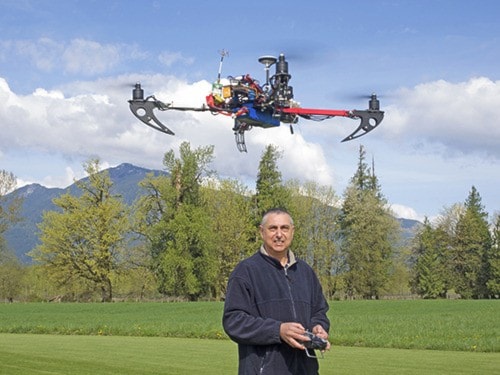Great things can happen when parents identify their child’s strong interests and cultivate them into lifelong pursuits.
That’s how it went for the late Jack and Clare Hatton and their son, Jim, who has been flying radio-control airplanes since he was a student at Hope Secondary.
“From a very early age, 2 or 3, I was drawn to aviation,” said Hatton on Monday. “Dad took me to the Hope airport to watch the water bombers take off to fight fires in Manning Park back in the 60's. I couldn't get enough of planes.
“I got started flying R/C in 1978,” he recalled. “A friend of mine, Tom Houlden, got a radio-control plane for Christmas. When my dad saw that Tom was showing off with it, he decided that I must have one too, or suffer.
“There was a hobby shop in Hope at the time, but the fellow for some reason wouldn't order it for me — even when my parents requested it. We ordered the first one out of Burnaby,” said Hatton, a 1981 grad.
At that time, all R/C planes had noisy internal-combustion motors and had pretty primitive control units, by today’s standards. Hatton said modern controllers run between $30 and $3,000 but he has settled on a $750 14-channel Futaba unit that can store the profiles of various aircraft.
When he switches between his quadcopter and his Styrofoam-based AXN Floater Jet — two very-different types of aircraft — he changes the profile and the same controller is suddenly controlling ailerons instead of tilting four props.
“The AXN was my first electric plane,” said Hatton. “I didn’t think I wanted to get into — but now, I like it. This is such a beautiful plane to fly and I can just throw it in my car and off I go.”
At the Fraser Valley RC Flyers’ club airfield on Monday, Hatton used an elastic cord to launch the plane, which has one pusher-prop motor. It can also be tossed by hand. The AXN’s design allows it to glide without power and can even be landed without engine power — a great advantage if the battery is running low.
“Return to home” is something that wives can do via cell phone (in fact, one made that call on Monday morning and sent one flyer packing) — but the technology is now offered to R/C flyers who have lost sight of their aircraft or have lost the radio signal.
Hatton said he lost a new $400 plane that had the “return to home” function, though he didn’t trust that it would work. He was flying at the Broken Prop club’s airfield on the Gouwenberg farm behind Seabird Island.
“I lost my video signal, then I lost the radio signal and I saw $400 flying straight away from me.”
Hatton contacted farm owner, Henry Gouwenberg, to notify him of the lost plane that might have landed in a cornfield. He soon had a call back that the plane had been found… broken up.
“It had an automatic return home function built in,” said Hatton. “It actually had come back later and was circling overhead, waiting for me to bring it in — but I hadn’t noticed. It apparently lost power and crashed. I could salvage the parts, though.
“I don’t fly to crash,” added Hatton. “I hate building and I hate fixing. It takes quite a bit of tenacity to work through the problems you encounter in R/C.”
What he loves is working with all the cool technology available to R/C flyers. He got his quadcopter synched up with his controller, then hovered before sending it over 200 metres toward the Fraser River at an altitude of perhaps 50 metres.
While doing this, he slipped on a pair of video goggles that were radio-linked to the quadcopter. “This gives me the FPV or ‘first person view,’” explained Hatton.
Rather than looking at the copter from the ground, the goggles blocked his actual view and gave him the view that a mouse might have, if it were stowed away on the quadcopter.
“It’s a whole different experience… like being in a matrix,” he said.
The goggles allowed him to see over the trees and up and down the river, which was not visible from the ground.
Hatton took off his goggles, made a command on his hand-set, then set it down, saying, “Now we’ll see if return-to-home works. It should be able to land within 8 feet of where it took off.”
While we watched, the quadcopter automatically came back until it was high overhead, then it began a slow descent. When it was about 10 metres off the ground, it paused to wait for Hatton’s command. Receiving none, it went back to autopilot and landed smoothly and accurately, then turned itself off.
Extremely cool.
Hatton is a fair-weather flyer with an aversion to heat and mosquitoes… so when he’s not flying — or fixing — he’s often working on his blog about the R/C sport, at james-mylifeinrcflying.blogspot.ca . He has had over 500,000 views so far.
Hatton shares his current experiences in the sport and he also has scanned and posted a large collection of R/C Modeler magazines that were left to him when his friend Brian Rabbitt passed away in 1989. Viewers like to go into the old issues for model plans, said Hatton.
You may see Hatton flying at local fields in the Hope area this summer. If you’d like to learn more about the Fraser Valley club, see their site at fvrcf.com. Visitors are welcome to visit the FVRCF field at no cost, with weekend mornings being the busiest, said Hatton.
